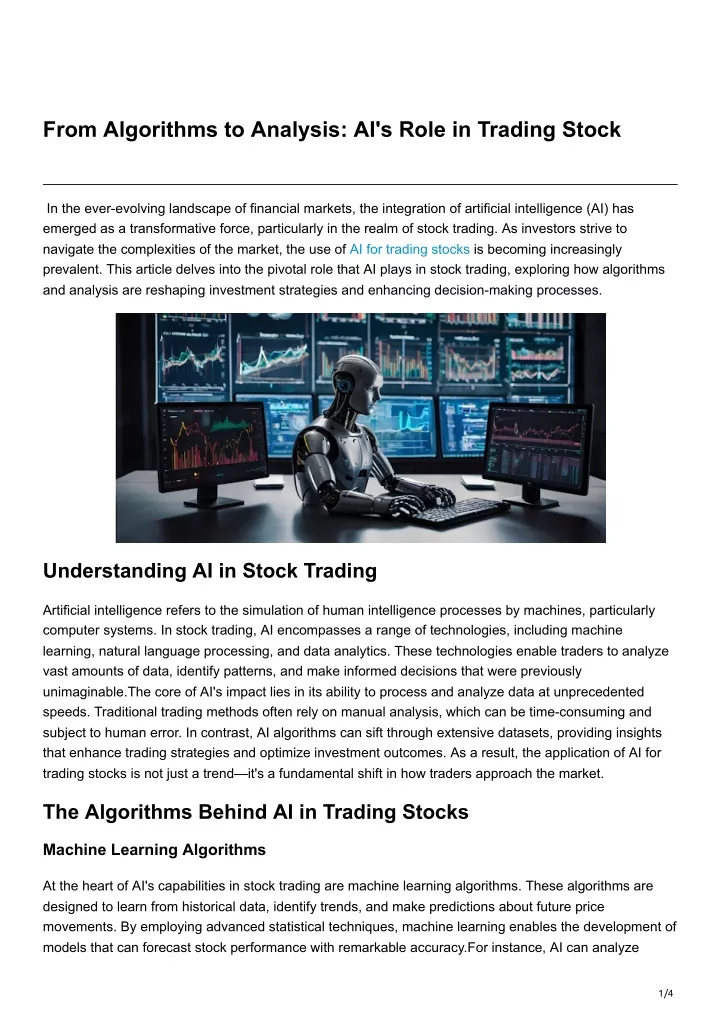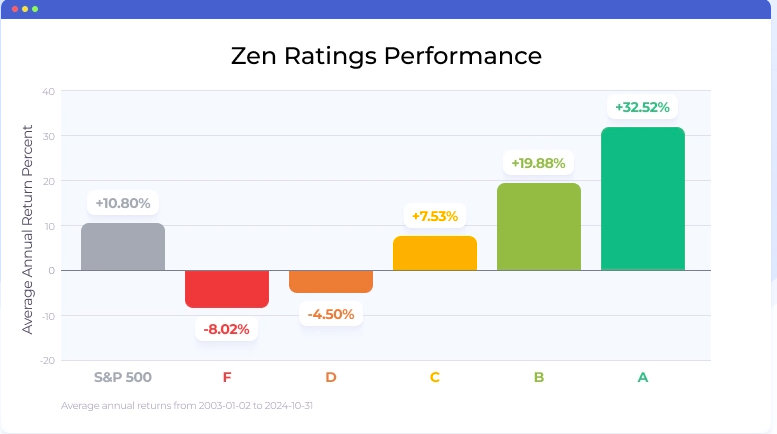20 Good Tips On Choosing AI Stock Investing Analysis Websites
20 Good Tips On Choosing AI Stock Investing Analysis Websites
Blog Article
Top 10 Suggestions To Evaluate Ai And Machine Learning Models For Ai Stock Predicting/Analyzing Platforms
Analyzing the AI and machine learning (ML) models used by stock prediction and trading platforms is crucial in order to ensure that they are accurate, reliable and useful insights. Poorly designed or overhyped models can result in faulty predictions as well as financial loss. Here are the top 10 tips to evaluate the AI/ML models on these platforms:
1. The model's design and its purpose
Clarified objective: Determine the objective of the model, whether it is to trade on short notice, investing long term, analyzing sentiment, or managing risk.
Algorithm disclosure: Find out if the platform discloses which algorithms it employs (e.g. neural networks and reinforcement learning).
Customization. Find out whether the model is able to be modified according to your trading strategy or level of risk tolerance.
2. Assess the Model Performance Metrics
Accuracy: Verify the accuracy of the model in predicting future events. However, don't solely rely on this metric since it can be inaccurate when applied to financial markets.
Accuracy and recall - Examine the model's capability to recognize genuine positives while minimizing false positives.
Risk-adjusted gain: See if the predictions of the model can lead to profitable transactions, after taking into account the risk.
3. Test the model using backtesting
Historical performance: Test the model using historical data to see how it would have been performing in previous market conditions.
Testing out-of-sample: Ensure that your model has been tested with data it was not used to train on in order to avoid overfitting.
Analyzing scenarios: Evaluate the model's performance during various market conditions (e.g., bear markets, bull markets and high volatility).
4. Check for Overfitting
Signs of overfitting: Search for models that do exceptionally well with training data, however, they perform poorly with unobserved data.
Regularization: Determine if the platform is using regularization methods, such as L1/L2 or dropouts in order to prevent overfitting.
Cross-validation (cross-validation): Make sure the platform is using cross-validation for assessing the generalizability of the model.
5. Examine Feature Engineering
Important features: Make sure that the model is based on important attributes (e.g. price or volume, as well as technical indicators).
The selection of features should be sure that the platform selects features with statistical importance and avoiding redundant or unnecessary information.
Dynamic feature updates: See whether the model is adjusting over time to new features or to changing market conditions.
6. Evaluate Model Explainability
Interpretability: The model should provide clear explanations to its predictions.
Black-box Models: Be cautious when platforms employ complex models without explanation tools (e.g. Deep Neural Networks).
User-friendly insights: Find out if the platform provides actionable insights in a form that traders can comprehend and apply.
7. Test the ability to adapt your model
Changes in the market - Make sure that the model is adjusted to the changing market conditions.
Continuous learning: Make sure that the platform regularly updates the model with fresh data to boost the performance.
Feedback loops: Make sure the platform includes feedback from users as well as actual results to improve the model.
8. Check for Bias or Fairness
Data bias: Ensure that the information used to train is a true representation of the market and without biases.
Model bias - Check to see the platform you use actively monitors the presence of biases within the model's predictions.
Fairness - Make sure that the model you choose to use isn't biased in favor of or against particular stocks or sectors.
9. Evaluation of Computational Efficiency
Speed: Check whether the model can make predictions in real-time, or at a low latency. This is particularly important for high-frequency traders.
Scalability: Determine if the platform is able to handle large amounts of data with multiple users, without performance degradation.
Utilization of resources: Ensure that the model is optimized to make efficient use of computational resources (e.g. the use of GPUs and TPUs).
Review Transparency & Accountability
Model documentation - Make sure that the model's documentation is complete details on the model including its structure the training process, its limits.
Third-party audits: Verify if the model has been independently audited or validated by third parties.
Error Handling: Determine if the platform is equipped with mechanisms that detect and correct any errors in the models or in failures.
Bonus Tips
User reviews: Conduct user research and research case studies to determine the model's performance in real life.
Trial period for free: Try the accuracy and predictability of the model with a demo or free trial.
Support for customers - Ensure that the platform you choose to use is able to provide robust support to solve technical or model related issues.
These suggestions will assist you to examine the AI and machine learning algorithms employed by platforms for stock prediction to make sure they are reliable, transparent and aligned with your trading goals. View the most popular best ai stock trading bot free for more tips including ai stocks, ai for trading, best ai stock, ai investment platform, ai stock, ai investing app, ai for stock trading, ai stock, ai stocks, best ai stock trading bot free and more.
Top 10 Tips To Assess The Regulatory Compliance Of Ai Stock Predicting/Analyzing Platforms
Compliance with regulatory requirements is an essential factor when looking at AI platform for analyzing and predicting stocks. Compliance ensures that the platform complies to financial regulations and adheres to legal frameworks and protecting user information. This minimizes the chance of financial penalties or legal concerns. Here are the top 10 suggestions for evaluating the compliance with regulations of these platforms:
1. Verify that you have a valid license and registered
Regulators: Confirm that the platform is registered and licensed by the appropriate financial regulatory body (e.g. SEC, FCA, ASIC, etc.) in your nation.
Broker partnership: If a platform incorporates brokers, make sure that brokers are also properly licensed and regulated.
Public records: Go to the website of the regulator to see the status of registration as well as past violations.
2. Review Data Privacy Compliance
GDPR when operating in the EU or offering services to EU users the platform must be in compliance with the General Data Protection Regulation.
CCPA for users living in California, verify compliance to the California Consumer Privacy Act (CCPA).
Policies on handling data: Check the data privacy policy of the platform to determine the way it describes the data collection, storage and sharing.
3. Evaluate Anti-Money Laundering (AML) Actions
AML Policies: Make sure the platform has AML policies that are strong to stop and detect money laundering.
KYC procedures - Ensure that the platform adheres to Know Your Customer procedures for authenticating user identities.
Transaction monitoring: Verify that the platform tracks transactions in order to identify suspicious activity and notify authorities.
4. Verify compliance with Trading Regulations
Market manipulation: Check that the platform is equipped with measures to prevent manipulating the market, for example, spoofing and wash trading.
Order types: Ensure whether the platform is in compliance with the regulations regarding types of orders.
Best execution: Check if the platform adheres to best execution practices, ensuring trades are executed at the best available price.
5. Cybersecurity Assessment
Data encryption: Make sure the platform has encryption in place to protect the data of users in transit and at rest.
Incident response: Verify if the platform has a clearly defined incident response strategy for cyberattacks or data breaches.
Certifications: Determine if a platform has been accredited for cybersecurity (e.g. ISO 27001, SOC 2)
6. Transparency Evaluation and Transparency Evaluation and Disclosure
Fee disclosure: Ensure that the platform clearly outlines any fees, hidden or additional charges.
Risk disclosure: Check if the platform offers clear risk disclosures, specifically when it comes to high-risk trading or leveraged strategies.
Performance reporting: Check whether the platform is clear and accurate reports on performance for its AI models.
7. Check for compliance with international regulations
Cross-border trading. If you intend to conduct international trade, make sure whether your platform is compliant with all regulations applicable to it.
Tax reporting: Verify whether the platform offers tools or reports that assist users in complying with tax regulations (e.g., FIFO rules in the U.S.).
Conformity with international sanctions: Make sure your platform is in strict compliance with these regulations and doesn't permit trading between prohibited countries or entities.
8. Examine Record-Keeping and Audit Trails,
Transaction records: The platform needs to maintain detailed records on all transactions to be used for auditor and regulatory reasons.
User activity logs Verify that your platform keeps track of all activities by users, such as transactions, logins, and adjustments to settings for accounts.
Audit readiness: Make sure that the platform can provide necessary documents and logs in the event an audit by a regulatory agency.
9. Verify the compliance of AI Specific Regulations
Algorithmic trading rules: If using a platform which supports algorithmic trading, ensure it is compatible with relevant regulatory frameworks such as MiFID II or Reg SCI, in Europe and the U.S.
Fairness and bias Determine whether the platform modifies or monitors its AI models to ensure fair and ethical trading.
Explainability: As stipulated by certain regulations, the AI platform should be able to provide clear explanations for AI-driven decisions and forecasts.
Review User Feedback & Review History of Regulatory History
Reviewer feedback: Go through the feedback of users and then compare it with the platform's regulatory standards.
The history of regulatory compliance: Find out if the platform has any records of violations to the law such as fines, penalties, or sanctions.
Third-party audits: Verify that the platform has regular audits by third parties to ensure compliance with regulations.
Bonus Tips
Legal consultation: Consult with a legal expert about the compliance of the platform with relevant rules.
Trial period for free: You may avail a demo or a free trial to try out the features that ensure compliance of the platform as well as its documentation.
Customer support - Check that the platform is able to assist with any compliance-related questions or issues.
With these suggestions to evaluate the compliance with regulations of AI stock predicting/analyzing trading platforms and ensure that you select one that adheres to legal frameworks and protects your interests. Compliance does more than minimize legal risks, it also improves confidence in the platform. Follow the most popular ai options for blog advice including free ai stock picker, invest ai, best ai for stock trading, best ai trading platform, stock predictor, chart ai trading, stock trading ai, best ai stocks, ai stock trader, ai stock price prediction and more.